Back to Football Tech Main Page
Generative AI in the NFL
The NFL has been integrating Generative AI to enhance various aspects of the game, from player performance analysis to fan engagement. Here’s a detailed look at some of the key generative AI systems currently in use, along with their key features and components:
- Amazon Q Business
- Bedrock-Based Research Tool
- Next Gen Stats
- NFL Technology Innovation Hub
- Generative AI for Fan Engagement
- Player Performance and Health Monitoring
- AI-Enhanced Coaching Tools
- Broadcast and Media Production
- AI-Driven Marketing and Advertising
- Security and Compliance
- AI for Game Strategy and Analysis
- AI in Scouting and Recruitment
- AI for Injury Prevention and Rehabilitation
- AI-Enhanced Fan Experiences
- AI for Environmental Sustainability
1. Amazon Q Business
Powering Productivity with Amazon Q Business
Running the media operations for a league as massive and dynamic as the NFL involves managing vast amounts of information – historical data, production guides, style manuals, legal documents, and much more. Sifting through all of this efficiently is a huge task. This is where Amazon Q Business comes in.
The NFL’s media division is using Amazon Q Business as a sophisticated tool to streamline workflows and boost productivity. Think of it as a super-smart, AI-powered research assistant that can instantly access and understand all their internal documentation.
Here’s how it works and its key components:
- Talk Like You Normally Would (Natural Language Processing): Instead of digging through folders or using rigid search terms, NFL employees can simply ask Amazon Q Business questions in plain, everyday language, just like they would ask a colleague. The AI understands the query and finds the relevant information.
- All Your Information in One Place (Centralized Database): The system connects to and organizes all of the NFL media’s internal documentation in a single, easily accessible database. This eliminates the need for employees to hunt through disparate systems or physical files.
- Connecting the Dots (API Integration): Amazon Q Business can also connect with other NFL systems. This means it can quickly pull in relevant data from various sources to provide more comprehensive answers, helping employees get the full picture fast.
By allowing staff to quickly find and synthesize information from their internal knowledge base using simple questions, Amazon Q Business helps the NFL’s media division operate more efficiently, freeing up time and resources for other important tasks. It’s a prime example of how Generative AI is being used to improve day-to-day operations within the league.
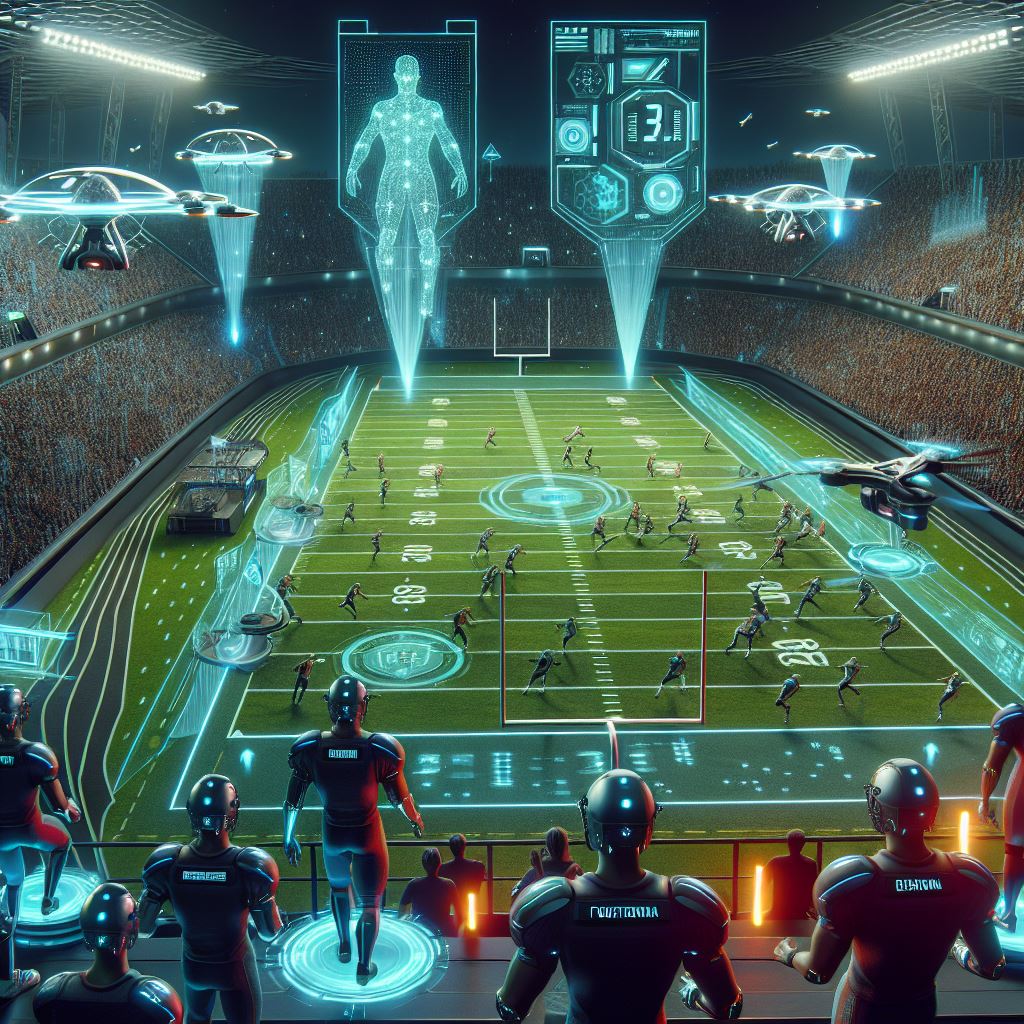
2. Bedrock-Based Research Tool
This Bedrock-Based Research Tool is seamlessly integrated into the NFL’s vast media asset management system. Its purpose is to allow producers and media professionals to use AI to quickly locate and retrieve specific video footage from the immense archive of NFL games.
Here’s a look at its key features and how it helps:
- Ask for the Footage You Need (NLP for Querying): Just like with Amazon Q Business, users can make requests using simple, natural language commands. Instead of typing in complex keywords or Browse through metadata tags, they can just ask the tool to “show me all of Patrick Mahomes’ touchdown passes from the 2024 season” or “find the defensive stop by the 49ers in the third quarter of the championship game.” The AI understands the request.
- Retrieving the Right Clips (API Calls): Behind the scenes, the AI translates the natural language query into technical commands (API calls) that can search and retrieve the relevant video clips from the NFL’s databases, including potentially linking to the rich data from Next Gen Stats to find specific plays based on performance metrics.
- Seamless Access to Everything (Integration with Media Asset Management): Because the tool is integrated directly with the media asset management system, when the AI finds the requested footage, producers get immediate and seamless access to all the associated assets – different camera angles, isolated player feeds, stadium audio, and more. This makes it incredibly efficient to find exactly what they need for broadcasts, highlights, social media content, and other productions.
This generative AI tool essentially acts as an intelligent video librarian, allowing the NFL’s media teams to quickly surface specific moments and plays from their extensive archives, dramatically speeding up the production process and enabling more dynamic and responsive content creation.
3. Next Gen Stats
The Data Engine: Unpacking the Game with Next Gen Stats
If you’ve watched an NFL broadcast in recent years, you’ve likely heard stats like “Player X reached a top speed of 21 MPH” or “This receiver had 3.5 yards of separation on that catch.” These aren’t just numbers pulled out of thin air; they come from Next Gen Stats.
Developed in partnership with AWS (Amazon Web Services), Next Gen Stats is the NFL’s powerful system that tracks the precise movements of every player and the ball on every play. It’s a massive data engine, generating an astounding nearly 300 million data points per season! This granular data is fundamentally changing how we analyze and understand the game.
Here’s how this incredible system works and its key components:
- Tracking Every Move (Player and Ball Tracking): Tiny sensors placed on player equipment and in the football capture incredibly detailed movement data – their location, speed, acceleration, and direction – multiple times every second. This creates a digital footprint of every play.
- Turning Data into Insights (Machine Learning Models): Simply collecting data isn’t enough; you need to make sense of it. The NFL uses Machine Learning Models, often built and deployed using Amazon SageMaker, to analyze this enormous dataset. These models process the raw tracking data to generate the advanced metrics we see and hear, like completion probability, route efficiency, or yards after contact.
- Making Sense of the Numbers (Data Visualization): To make this complex data understandable and actionable, the NFL utilizes tools like Amazon QuickSight. This helps create clear and compelling data visualizations – charts, graphs, and graphics – that are used internally by teams for analysis and planning, and externally by broadcasters to provide fans with deeper insights during games.
Next Gen Stats provides an unprecedented level of detail about the physical execution of football. It’s the engine that powers many of the advanced statistics that inform coaching decisions, player evaluation, and enhance the fan experience by offering a look “under the hood” of every play.

4. NFL Technology Innovation Hub
Dreaming Up the Future: The NFL Technology Innovation Hub
Beyond the technology already on the field, the NFL is actively thinking about what’s next. Where will technology take the game and the fan experience in the coming years? This is the mission of the NFL Technology Innovation Hub.
Think of this hub as the NFL’s dedicated think tank or R&D lab for cutting-edge technology. Its primary focus is on exploring, developing, and integrating emerging technologies into all facets of the league’s operations, specifically aiming to enhance gameplay and the fan experience. It’s where new ideas are born and tested to see how they could shape the future of football.
Here’s what makes the Innovation Hub tick and its key components:
- Bringing Minds Together (Cross-Functional Collaboration): Innovation rarely happens in a silo. The Hub brings together experts from a wide range of fields – technology specialists, football operations personnel, media producers, and more – to brainstorm and develop new ideas from multiple perspectives.
- Testing New Game-Changing Tech (Optical-Tracking Technology): The Hub is involved in developing and testing specific technologies with practical applications in the game. A great example is the use of Optical-Tracking Technology for projects like the potential automated line-to-gain measurement system, aiming for more precise and faster spotting of the ball compared to traditional chains.
- Working with the Best Ideas (Crowd-Sourced Development): The NFL doesn’t limit innovation to just internal teams. The Hub actively engages with external technology partners, startups, and academic institutions to tap into a wider pool of expertise and ideas, bringing promising outside technologies into the NFL ecosystem for testing and potential implementation.
The NFL Technology Innovation Hub is the league’s commitment to staying at the forefront of technological advancement. It’s the place where the next generation of tools for improving the game on the field and making the fan experience more engaging is being imagined, developed, and brought to life.
5. Generative AI for Fan Engagement
Connecting with You: Generative AI for Fan Engagement
The NFL knows that the game is ultimately about the fans. As technology evolves, so does the league’s ability to connect with its massive and diverse fanbase in more personal and exciting ways. Generative AI is playing a key role in creating these next-level fan experiences.
These AI systems are being used to move beyond one-size-fits-all content and deliver personalized experiences that make each fan feel more connected to their favorite teams and players.
Here’s how Generative AI is enhancing your fan experience:
- Content Tailored Just for You (Personalization Algorithms): Are you obsessed with your favorite team’s quarterback? Do you love watching defensive highlights? Personalization Algorithms powered by AI can learn your preferences based on how you interact with NFL apps and content. They then use this information to tailor the content you see, showing you custom highlight reels, news, and stats that are most relevant to your interests.
- Your Always-On NFL Expert (AI-Driven Chatbots): Have a quick question about a game stat, a player, or the schedule? AI-Driven Chatbots can provide real-time updates and interact with fans in a conversational way. They can answer your questions instantly, guide you to information, and provide a more engaging way to get the facts you need during the game or throughout the week.
- Highlights Made Instantly (Content Generation): Imagine getting a personalized highlight reel of only your fantasy players’ best moments right after the games finish. Generative AI can automatically create highlight reels, summaries, and other content based on specific criteria. This means fans can get faster access to the moments that matter most to them, delivered in a customized package.
By leveraging Generative AI, the NFL is creating a more interactive, personalized, and engaging experience for fans, bringing them closer to the action and the players they love through tailored content and smart, responsive digital tools.
Football Tech – Generative AI
6. Player Performance and Health Monitoring
Keeping Players in Peak Condition: AI for Performance and Health
Player health and performance are absolutely paramount in the NFL. Keeping athletes on the field and performing at their highest level requires sophisticated monitoring and analysis. Artificial Intelligence is increasingly being used to gain deeper insights into the physical well-being and capabilities of players.
AI systems are processing vast amounts of data, often collected from wearable technology, to provide teams with valuable insights into player fitness, identify potential injury risks before they happen, and optimize the recovery process.
Here’s how AI is contributing to player performance and health:
- Collecting the Data (Wearable Sensors): Many NFL players now wear sensors during practice and training that collect detailed data on their movements, speed, workload, and even some vital signs. This provides a constant stream of information about their physical state.
- Spotting Potential Issues Early (Predictive Analytics): AI systems analyze the data from wearable sensors alongside historical information. By identifying subtle patterns or changes in a player’s performance or movement data that might not be obvious to the human eye, the AI can use Predictive Analytics to flag potential injury risks. This allows teams to take proactive, preventive measures to help keep players healthy.
- Personalizing the Road to Recovery (Recovery Optimization): When a player does get injured, AI can help optimize their rehabilitation. By analyzing data on their injury, their body’s response to treatment, and their progress, AI can help tailor recovery programs specifically to that individual player, aiming for a safer and more efficient return to the field.
By leveraging AI to analyze data from wearable sensors, NFL teams are gaining powerful new tools to monitor player fitness, identify potential risks proactively, and personalize recovery, all with the goal of keeping their athletes healthy and performing at their peak.
7. AI-Enhanced Coaching Tools
The Coach’s AI Partner: Tools for Smarter Game Planning
NFL coaching is an incredibly demanding job, requiring countless hours of film study, strategic planning, and rapid adjustments. Coaches are always looking for an edge, and Artificial Intelligence is emerging as a powerful partner in the war room, helping them break down opponents and build winning game plans.
AI-Enhanced Coaching Tools are sophisticated systems that process vast amounts of data and game footage to provide coaches with detailed analyses, helping them develop more effective strategies and be better prepared for anything the opposition throws at them.
Here’s how AI is giving coaches a technological assist:
- Spotting the Opponent’s Tendencies (Pattern Recognition): AI can analyze countless plays across multiple games much faster and more comprehensively than humans alone. It excels at identifying subtle patterns in opponent strategies, player formations, and tendencies in different game situations. This helps coaches anticipate what the other team might do and develop countermeasures.
- Breaking Down the Action (Video Analysis): Coaches spend hours watching film, but AI can make that process more efficient. AI tools can automatically break down game footage, tagging key moments, highlighting specific players, or isolating certain types of plays based on search criteria. This allows coaches to quickly pinpoint the most relevant clips for study and analysis.
- Exploring Strategic Options (Strategy Optimization): Some advanced AI tools are being developed to go beyond just analysis and actually help with planning. By considering a team’s strengths, an opponent’s weaknesses, and situational data, these tools can suggest optimal plays and tactics for specific down-and-distance scenarios or areas of the field, offering coaches potential strategies they might not have initially considered.
By providing deep analytical insights, streamlining film study, and even suggesting strategic options, AI-enhanced coaching tools are becoming increasingly valuable resources for NFL coaching staffs, helping them to prepare more effectively and make smarter decisions on game day.
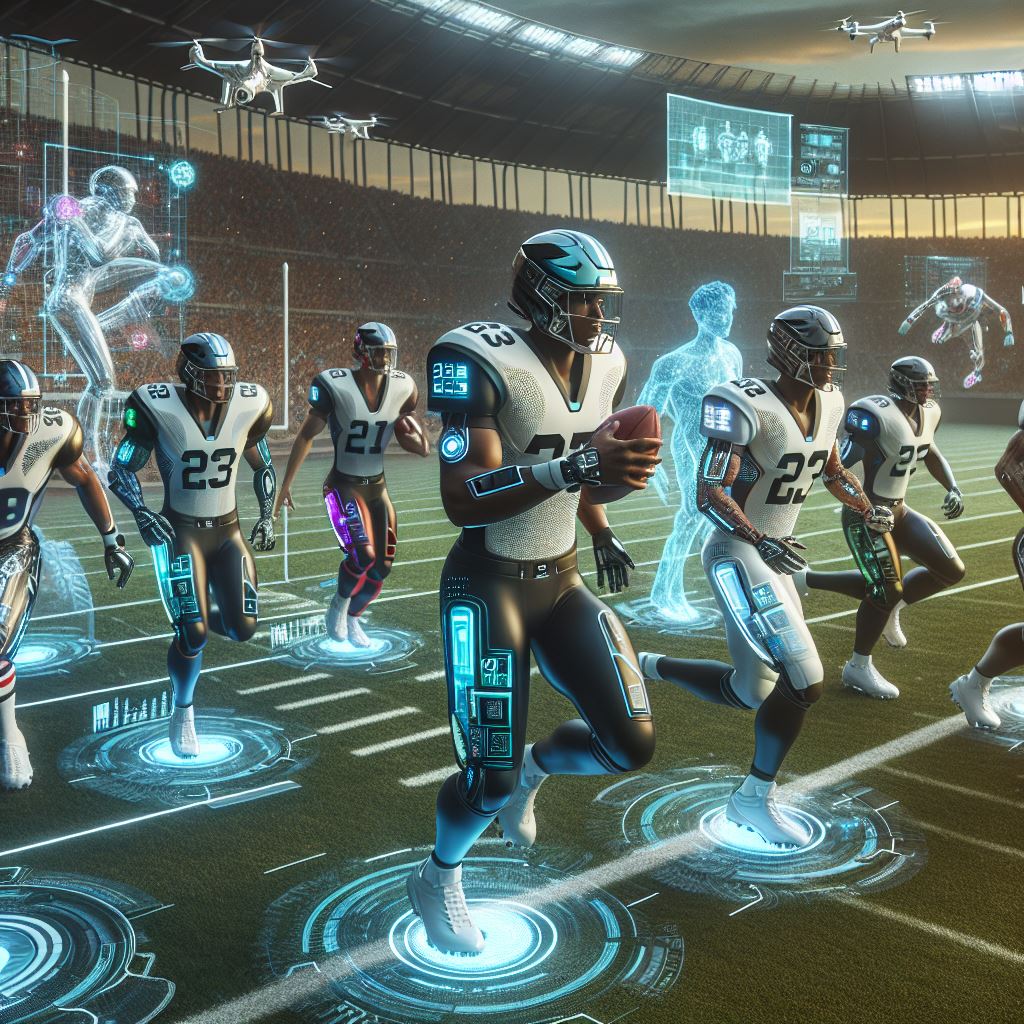
8. Broadcast and Media Production
Bringing the Game to You: AI in Broadcast and Media Production
For millions of fans, the NFL experience happens through broadcasts and digital media. Making sure that content is exciting, informative, and delivered quickly requires a massive production effort. Artificial Intelligence is now stepping in to help automate parts of this process and add new layers of insight to the viewing experience.
AI systems are being used to automate tasks and provide real-time analysis, making NFL broadcasts and media content more dynamic and efficient to produce.
Here’s how AI is impacting how you watch the game:
- Instant Highlights and Summaries (Automated Content Creation): AI can automatically identify key moments in a game – touchdowns, big plays, turnovers – and rapidly generate highlight reels and game summaries with minimal human intervention. This means content can be created and distributed much faster across various platforms, so you can relive the best moments almost instantly after they happen.
- Adding Depth to the Broadcast (Real-Time Analysis): AI systems can process live game data from sources like Next Gen Stats and instantly generate insights. This real-time analysis provides commentators and analysts with immediate statistics and graphical overlays that add valuable context and depth to the live broadcast, giving you a richer understanding of the strategies and performances on the field.
- Making Production More Efficient (Efficiency Tools): By automating tasks like logging plays, identifying key clips, and generating initial content drafts, AI significantly reduces the workload for production teams. This allows talented human professionals to focus on higher-level creative tasks, ultimately leading to a smoother and more polished broadcast product.
By automating repetitive tasks and providing instant analytical insights, AI is helping the NFL deliver faster, more engaging, and more informative broadcasts and media content to fans everywhere.
9. AI-Driven Marketing and Advertising
Reaching the Fans: AI in Marketing and Advertising
With millions of fans around the world, the NFL needs smart ways to communicate with them, promote the league, and share messages from its partners. Simply sending the same message to everyone isn’t the most effective approach. This is where Artificial Intelligence is becoming a powerful tool in the NFL’s marketing playbook.
AI-Driven Marketing and Advertising focuses on using data and intelligent systems to create more targeted, relevant, and effective campaigns that resonate with individual fans.
Here’s how AI helps the NFL connect with you:
- Understanding What Fans Love (Data Analytics): The NFL collects a lot of data about how fans engage – which teams they follow, what content they watch, what merchandise they buy, and how they interact online. AI is used for Data Analytics to crunch these numbers and identify trends, preferences, and different fan segments, helping the league understand what truly matters to its audience.
- Showing You What Matters to You (Personalized Advertising): Based on the insights gained from data analysis, AI can help create and deliver personalized advertising. This means you’re more likely to see ads or promotional messages about your favorite team, players you follow, or products that align with your interests, making the marketing feel more relevant and less like generic spam.
- Making Campaigns Smarter on the Fly (Campaign Optimization): AI systems can monitor how fans are responding to different marketing campaigns in real-time. Based on this information, the AI can help adjust marketing strategies, like changing where ads are shown, modifying the messaging, or targeting different groups, to improve their effectiveness and ensure the right messages reach the right fans at the right time.
By using AI to understand fan behavior and personalize communications, the NFL can create more engaging and effective marketing and advertising campaigns, strengthening the connection with its massive fanbase.
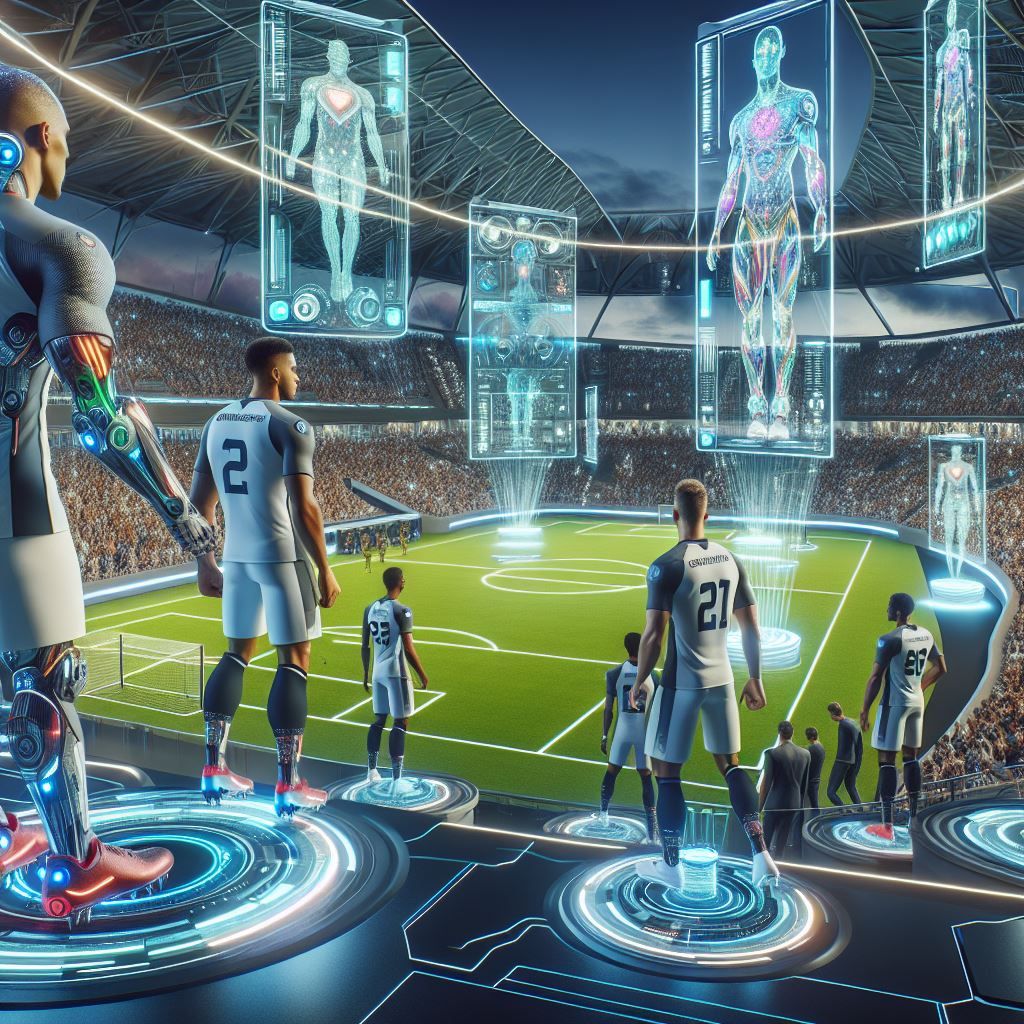
10. Security and Compliance
Protecting the Game: AI for Security and Compliance
In a complex organization like the NFL, ensuring the security of its digital infrastructure, communications, and sensitive data is absolutely critical. Maintaining compliance with various regulations and internal policies is equally important. Artificial Intelligence is playing an increasingly vital role in safeguarding the league’s operations.
AI systems are being deployed to constantly monitor various activities and data streams, helping to automatically detect potential security threats and ensure that operations adhere to necessary rules and standards.
Here’s how AI is contributing to security and compliance in the NFL:
- Spotting What Looks Unusual (Anomaly Detection): AI is excellent at processing massive amounts of data to identify patterns that fall outside the norm. In a security context, this means Anomaly Detection can flag unusual login attempts, strange data transfers, or other activities that might indicate a potential cyber threat or unauthorized access, often faster than humans could.
- Ensuring Rules Are Followed (Compliance Monitoring): The NFL operates under numerous regulations, both internal and external. AI systems can assist with Compliance Monitoring by automatically reviewing transactions, communications, and data handling processes to ensure they adhere to established policies and legal requirements, reducing the risk of violations.
- Instant Warning Signals (Automated Alerts): When a potential security threat or compliance issue is detected, time is of the essence. AI systems are set up to generate Automated Alerts that instantly notify the relevant security personnel or compliance officers. This allows teams to investigate and respond to potential problems quickly, minimizing potential damage or non-compliance issues.
By providing constant, intelligent monitoring capabilities, AI is helping the NFL enhance its security posture, detect potential threats and compliance deviations automatically, and ensure a more robust and resilient operational environment.
11. AI for Game Strategy and Analysis
The AI Strategist: Gaining an Edge in Game Planning
Football is often described as a chess match, with coaches constantly trying to anticipate their opponent’s moves and devise the most effective counter-strategies. In the quest for a competitive advantage, NFL teams are now turning to Artificial Intelligence to help analyze the game at a deeper, more complex level.
AI for Game Strategy and Analysis involves using powerful AI systems to model and predict outcomes, providing teams with data-driven insights to inform their strategic decisions and refine their game plans.
Here’s how AI is helping teams sharpen their strategies:
- Running Hypothetical Scenarios (Simulation Models): AI can run Simulation Models that play out thousands or even millions of hypothetical game scenarios. By inputting various strategies or play calls, the AI can predict potential outcomes based on vast historical data and opponent tendencies. This helps teams evaluate the potential effectiveness of different approaches before they ever hit the field.
- Deep Diving into the Opposition (Opponent Analysis): Building on the ability to identify patterns, AI excels at in-depth Opponent Analysis. It can scrutinize an opponent’s play-calling tendencies, defensive schemes, player matchups, and situational strategies with a level of detail and speed impossible for human analysts alone, providing coaches with comprehensive scouting reports.
- Factoring in the Elements (Weather Impact Prediction): Football is an outdoor sport often played in varying conditions. AI can help teams prepare by factoring in environmental data. Weather Impact Prediction models can assess how rain, wind, snow, or extreme temperatures might affect specific plays, player performance, or overall game flow, allowing coaches to tailor their strategy accordingly.
By providing sophisticated simulations, detailed opponent breakdowns, and even accounting for external factors like weather, AI for game strategy and analysis is becoming an invaluable tool for NFL teams looking to gain a strategic edge and make more informed decisions in their relentless pursuit of victory.
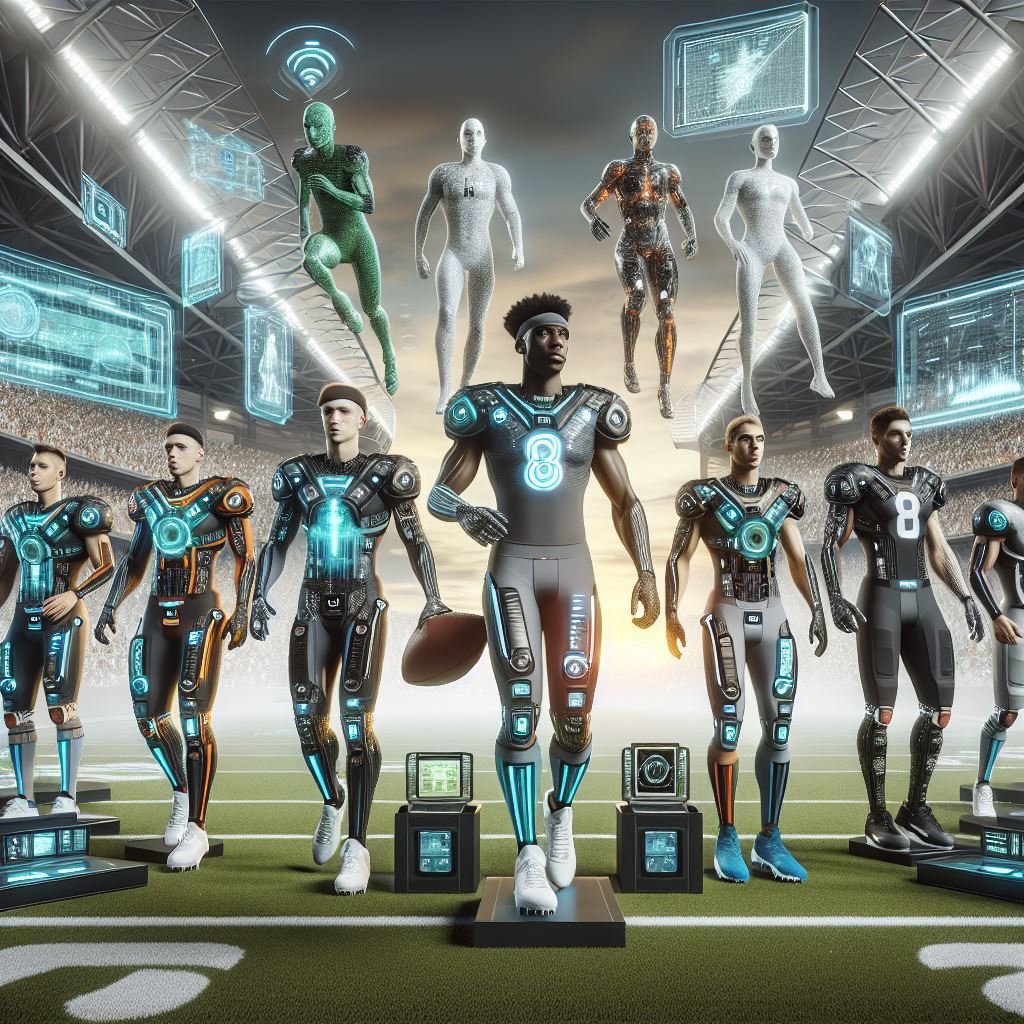
12. AI in Scouting and Recruitment
Finding the Next Stars: AI in Scouting and Recruitment
The NFL Draft is a pivotal moment for every team, where the future of the franchise can be shaped. Scouting college players is a massive undertaking, involving countless hours of watching film, attending games, and evaluating prospects. To gain a deeper understanding of potential recruits and make more informed decisions, NFL teams are increasingly turning to Artificial Intelligence.
AI in Scouting and Recruitment involves using AI systems to analyze vast amounts of data on college players, helping teams identify promising talent, predict how they might perform in the NFL, and make smarter choices during the draft and free agency periods.
Here’s how AI is assisting teams in finding talent:
- Analyzing On-Field Performance (Performance Metrics Analysis): AI can crunch numbers on traditional stats like yards and tackles, but also process more advanced data from college games (where available) and analyze player movements and actions within game footage. This evaluates player statistics and on-field performancewith a depth that goes beyond traditional methods, highlighting efficiency, consistency, and specific skills.
- Gathering a Fuller Picture (Social Media Monitoring): In addition to on-field performance, teams look at a player’s character and how they present themselves off the field. AI can analyze publicly available information, including potentially assessing players’ off-field behavior and public perception from social media and other online sources. This data provides another layer of context for evaluating a prospect. (Note: The use of AI for social media monitoring in recruitment raises privacy considerations and is a debated topic.)
- Highlighting Potential Prospects (Talent Identification): By combining analysis of performance data, physical metrics, and other relevant information, AI systems can highlight potential recruits who might be a good fit for a team’s specific needs or playing style. This helps scouting departments manage the enormous pool of college talent and focus their human evaluation efforts on the most promising candidates identified by the data.
By providing sophisticated data analysis and flagging potential prospects, AI is becoming a valuable supplement to traditional scouting methods, helping NFL teams make more data-driven decisions in the high-stakes world of player recruitment.
13. AI for Injury Prevention and Rehabilitation
Battling the Injury Bug: AI for Prevention and Rehabilitation
Injuries are an unfortunate reality in football, often impacting player careers and team performance. The NFL is constantly seeking ways to keep athletes healthy and, when injuries do happen, ensure they recover as effectively and safely as possible. Artificial Intelligence is becoming a crucial tool in this ongoing battle.
Building on the data collected from various sources, particularly wearable sensors, AI for Injury Prevention and Rehabilitation focuses specifically on using intelligent systems to help forecast potential injuries and create highly personalized recovery plans.
Here’s how AI is specifically targeting player health and recovery:
- Predicting Potential Injuries (Injury Prediction Models): By analyzing a player’s workload, movement patterns, fatigue levels, and historical health data captured by wearable sensors, AI can build Injury Prediction Models. These models can identify subtle signs or trends that might indicate a player is at increased risk of a specific type of injury, allowing teams to intervene with rest, altered training, or targeted conditioning before an injury occurs.
- Tailoring the Road Back (Customized Rehabilitation Programs): When a player is injured, their recovery journey is unique. AI can help create Customized Rehabilitation Programs by analyzing the specific injury, the player’s individual physiology, and their progress through recovery. This ensures that rehab plans are tailored to the player’s exact needs, optimizing the healing process.
- Monitoring Progress and Adjusting Plans (Progress Tracking): AI systems can continuously monitor a player’s progress during rehabilitation using data from sensors and performance tests. This allows for Progress Trackingthat helps medical staff make data-driven decisions on when to increase intensity, when to rest, and ultimately when a player is ready to safely return to practice and games, reducing the risk of re-injury.
By leveraging AI to analyze player data with an injury-specific focus, NFL teams are gaining powerful capabilities to predict and potentially prevent injuries, personalize and optimize rehabilitation, and ensure players return to the field in the best possible condition.
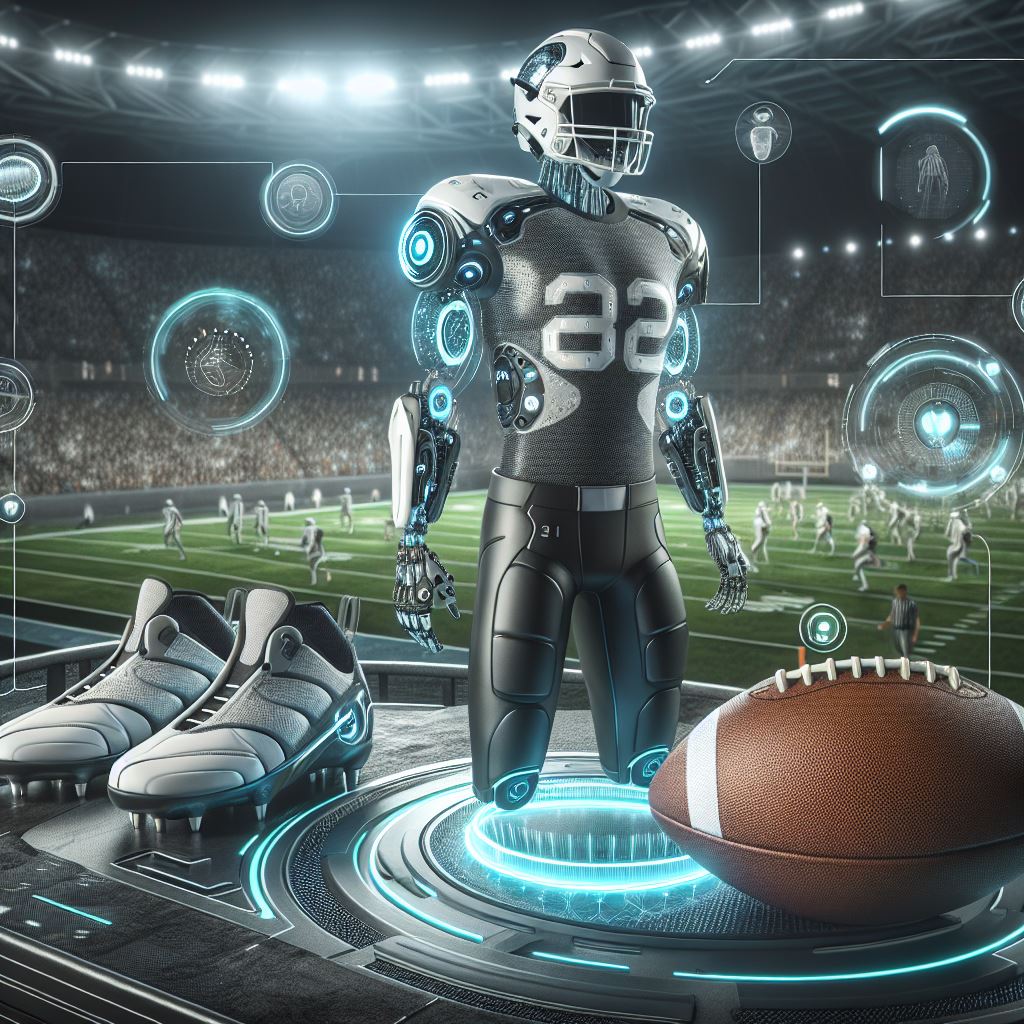
14. AI-Enhanced Fan Experiences
Stepping Into the Game: AI-Enhanced Fan Experiences
The NFL is always looking for innovative ways to bring fans closer to the action, whether they’re in the stadium or watching from afar. Artificial Intelligence is a key ingredient in creating more immersive and interactive experiences that go beyond traditional viewing.
AI-Enhanced Fan Experiences leverage intelligent systems to power next-generation ways for fans to engage with the game, including exciting applications in virtual and augmented reality.
Here’s how AI is making the fan experience more dynamic:
- Bringing the Stadium to You (Virtual Reality – VR): AI can help create and enhance Virtual Reality (VR)experiences that offer fans completely new perspectives. Imagine putting on a VR headset and feeling like you’re standing on the sideline, or even viewing the game from the quarterback’s perspective during a play. AI can process game data and footage to create realistic and dynamic virtual environments and perspectives for an incredibly immersive game experience.
- Adding Digital Magic to Your World (Augmented Reality – AR): AI is also crucial for Augmented Reality (AR) applications that enhance live game viewing with interactive elements. Using your smartphone or AR glasses, AI can overlay real-time stats, player information, or graphical visualizations onto your view of the actual field or your surroundings. Think of seeing a player’s speed displayed as they run, or visualizing play routes appearing on the field in front of you, making the viewing experience more informative and interactive.
- Experiences Tailored Just for You (Personalized Content): As mentioned before, AI’s ability to understand fan preferences is vital here too. It helps generate custom experiences based on fan preferences within VR/AR or other interactive platforms. This means the virtual views, AR overlays, or interactive features you see can be tailored to your favorite team, players, or specific aspects of the game you care about most, making the experience uniquely yours.
By powering realistic VR environments, dynamic AR overlays, and personalized interactive features, AI is helping the NFL create innovative and immersive fan experiences that allow you to engage with the game in ways previously only imaginable.
15. AI for Environmental Sustainability
A Greener Game: AI for Environmental Sustainability
Operating a major sports league with numerous stadiums, facilities, and large-scale events naturally has an environmental footprint. The NFL recognizes the importance of sustainability and is exploring how technology, including Artificial Intelligence, can help them reduce their impact and operate more efficiently and responsibly.
AI for Environmental Sustainability involves using intelligent systems to analyze data related to the league’s operations and identify opportunities to be more eco-friendly, from managing energy to handling waste.
Here’s how AI is contributing to a more sustainable NFL:
- Optimizing Energy Use: Stadiums and training facilities consume significant amounts of energy. AI can analyze data on energy usage patterns – when and where energy is being used, the impact of weather, etc. – to identify inefficiencies and recommend ways to monitor and optimize energy consumption. This can lead to significant savings in resources and reduced environmental impact.
- Improving Waste Management: Managing waste generated at games and events is a major logistical and environmental challenge. AI can analyze data related to waste streams to identify patterns in what types of waste are generated, where, and when. This helps optimize waste management strategies, identify opportunities to reduce waste generation, improve recycling rates, and potentially find innovative ways to repurpose materials.
- Tracking and Reporting Progress: To truly improve sustainability, it’s important to measure progress and be transparent. AI systems can assist with sustainability reporting by automatically collecting, analyzing, and reporting on various environmental metrics, such as energy saved, waste diverted from landfills, and carbon footprint. This data helps the NFL track its environmental impact, demonstrate progress towards its goals, and encourage accountability.
By leveraging AI to gain data-driven insights into its operational footprint, the NFL is working to implement more sustainable practices, conserve resources, and reduce its environmental impact, contributing to a greener future for the league and its facilities.
The Bottom Line: AI is Redefining the NFL
After exploring the many ways Generative AI is being woven into the fabric of the National Football League, one thing is clear: this technology isn’t just a buzzword; it’s a powerful force for transformation. From the intricate analysis of player performance and health data gathered by wearable sensors, to the strategic insights gained from AI-enhanced coaching tools that simulate scenarios and dissect opponents, AI is providing teams with unprecedented levels of understanding and efficiency.
Beyond the sidelines and practice fields, Generative AI is also revolutionizing how the league operates behind the scenes, streamlining workflows for teams like the media division using tools like Amazon Q Business, and enhancing critical functions like security and compliance through intelligent monitoring. Crucially, it’s also directly impacting the fans, enabling everything from personalized content delivered through AI-enhanced fan experiences like VR/AR and custom highlights, to smarter, more relevant AI-driven marketing and advertising.
By strategically leveraging these advanced AI capabilities, the NFL isn’t just incrementally improving existing processes; it’s actively improving the quality and strategy of the game itself while simultaneously creating a more immersive, personalized, and engaging experience for its massive fanbase.
As Generative AI continues its rapid evolution, we can expect its footprint within the league to grow even larger, unlocking new possibilities we can only begin to imagine. The NFL’s embrace of this technology firmly positions it as a frontrunner in sports innovation, showcasing how AI can redefine every aspect of a major professional sport.



Improbably. It seems impossible.